Welcome to The Essential Garden Guide, your source for expert gardening tips and advice to help you create a vibrant and flourishing garden. Whether you’re a seasoned gardener or just starting out, our comprehensive guide will provide you with the knowledge and tools you need to unlock the beauty of nature in your own backyard.
Key Takeaways:
- Understanding caladium bulbs is key to successful gardening.
- Timing and propagation methods play a crucial role in planting caladium bulbs.
- Creating ideal planting conditions enhances the growth and beauty of caladium bulbs.
- Proper watering and care are essential for the health and longevity of caladium bulbs.
- Managing caladium bulbs during dormancy ensures their survival and thriving.
Get ready to embark on a journey of discovery as we delve into the world of caladium bulbs. From planting to maintenance, troubleshooting to garden design, The Essential Garden Guide has you covered every step of the way. Let’s unlock nature’s beauty together!
Understanding Caladium Bulbs: A Key to Successful Gardening
To achieve successful gardening with caladium bulbs, it’s crucial to understand their unique care requirements and embrace organic gardening practices. Caladium bulbs are prized for their vibrant foliage and add a touch of tropical beauty to any garden. With The Essential Garden Guide, you can unlock the secrets to growing these stunning plants and create a thriving garden.
When it comes to caladium bulb care, organic gardening is key. By avoiding synthetic fertilizers and pesticides, you can cultivate a garden that is not only beautiful but also environmentally friendly. Organic gardening promotes healthy soil, beneficial insect populations, and overall ecosystem balance.
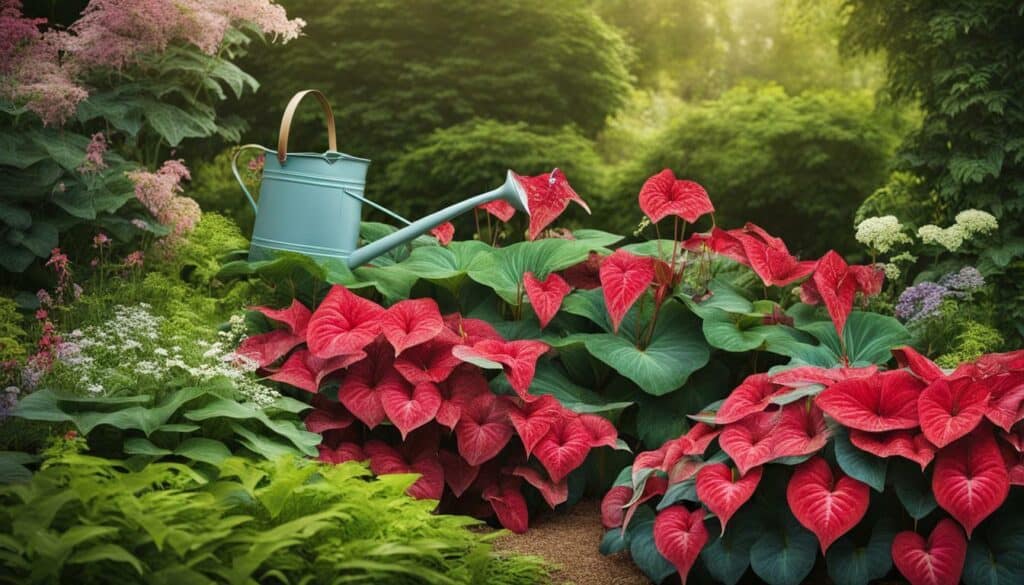
Caladium Bulb Care Checklist:
- Choose the right location: Caladiums thrive in partial shade, so select a spot that receives indirect sunlight.
- Prepare the soil: Incorporate organic matter, such as compost or well-rotted manure, to improve drainage and provide essential nutrients.
- Plant at the proper depth and spacing: Caladium bulbs should be planted with the top just barely covered with soil, approximately 12 inches apart.
- Water regularly: Keep the soil consistently moist, but avoid overwatering to prevent rotting.
- Feed with organic fertilizer: Apply a balanced organic fertilizer every few weeks during the growing season to promote healthy growth.
- Monitor for pests and diseases: Watch out for common issues like leaf discoloration, aphids, and fungal infections. Treat accordingly using organic pest control methods.
- Manage dormancy: Allow the foliage to naturally die back in the fall. Dig up the bulbs, clean off any excess soil, and store them in a cool, dry place until the next planting season.
By following these care guidelines and embracing organic gardening practices, you can enjoy vibrant caladium foliage year after year. The Essential Garden Guide provides detailed instructions and expert advice on every aspect of caladium bulb care, from planting to maintenance. Unlock nature’s beauty and create a garden that will captivate and inspire.
| Benefits of Organic Gardening for Caladium Bulbs |
|---|
| 1. Environmental sustainability |
| 2. Healthier soil and plants |
| 3. Safe for beneficial insects and wildlife |
| 4. Reduced chemical exposure for you and your family |
| 5. Cost-effective |
Planting Caladium Bulbs: Timing and Propagation Methods
Timing is everything when it comes to planting caladium bulbs, and understanding the different propagation methods can help you make the most of your garden maintenance and landscape design efforts. Caladium bulbs thrive in warm temperatures, so it’s crucial to plant them when the soil has warmed up and there is no risk of frost. This is typically in the spring, once the threat of freezing temperatures has passed and the soil has reached a consistent temperature of around 65°F (18°C).
When it comes to propagation, there are two main methods to consider: division and seed sowing. Division involves separating the bulbs into smaller sections, each with at least one bud, and planting them individually. This allows for quicker growth and larger, more robust plants. Seed sowing, on the other hand, involves planting the seeds directly into the soil or starting them indoors and then transplanting the seedlings once they have developed.
The Ideal Planting Conditions for Caladium Bulbs
Creating the ideal planting conditions for your caladium bulbs is essential for their success. These plants thrive in well-draining soil that is rich in organic matter. Before planting, it’s important to prepare the soil by incorporating compost or well-rotted manure to improve its fertility and structure. This will provide the bulbs with the nutrients they need to grow and establish themselves.
Additionally, caladium bulbs prefer partial shade to filtered sunlight. Choosing the right location in your garden is crucial for their growth and development. Look for an area that receives morning sun and afternoon shade, or a spot that is shaded by trees or shrubs. This will protect the plants from direct sunlight, which can cause the leaves to burn and fade.
Once you have selected the perfect location and prepared the soil, it’s time to plant the bulbs. Dig a hole that is approximately 2 to 3 inches deep and place the bulb with the pointed end facing up. Space the bulbs about 8 to 12 inches apart to give them room to spread and grow. After planting, water the bulbs thoroughly to promote root development and settle the soil around them.
| Timing | Propagation Methods | Ideal Planting Conditions |
|---|---|---|
| Plant in spring after the threat of frost has passed and soil temperatures have reached 65°F (18°C). | Consider division or seed sowing for propagation. | Plant in well-draining soil rich in organic matter. Choose a location with partial shade or filtered sunlight. |
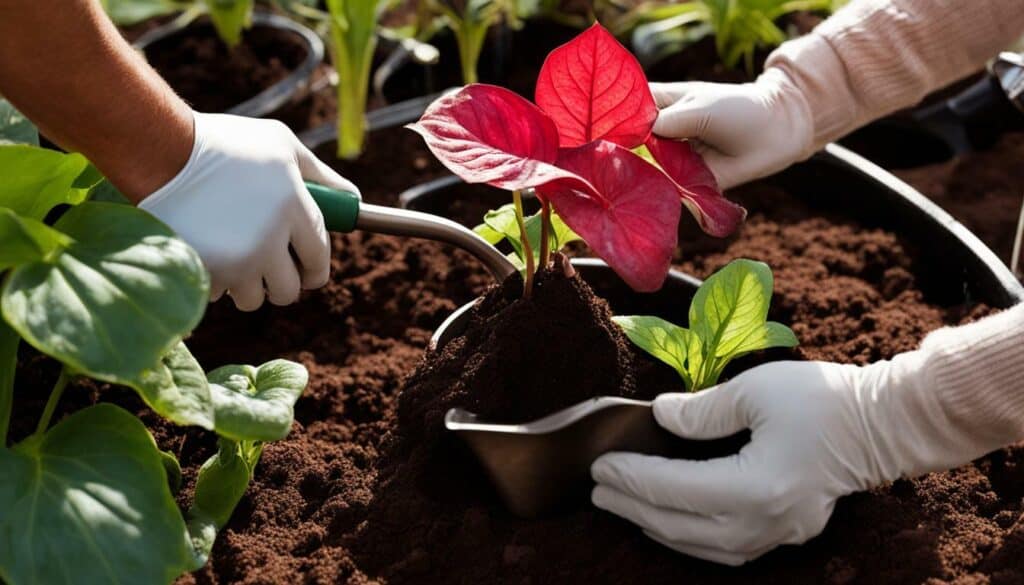
Creating Ideal Planting Conditions for Caladium Bulbs
To ensure the success of your caladium bulbs, it’s essential to create the ideal planting conditions by choosing the right location based on sunlight requirements and preparing the soil with the right mix of nutrients and texture. Caladium bulbs thrive in partial shade, so selecting a spot with dappled sunlight or filtered shade is ideal. Avoid areas with intense direct sunlight, as this can scorch the leaves.
When it comes to soil preparation, caladium bulbs prefer a rich, well-draining soil that retains moisture but doesn’t become waterlogged. Before planting, loosen the soil to a depth of at least 12 inches and remove any rocks or debris. Incorporate organic matter, such as compost or well-rotted manure, to improve soil fertility and drainage.
It’s also important to consider the texture of the soil. Caladium bulbs perform best in loamy or sandy loam soil, which provides good aeration and allows for easy root penetration. If your soil is heavy clay, you can amend it by adding sand or peat moss to improve its texture.

The Ideal Soil pH for Caladium Bulbs
| Soil pH Level | Effect on Caladium Bulbs |
|---|---|
| 5.5-6.5 | Optimal pH range for caladium bulbs, promoting nutrient uptake |
| Below 5.5 | Acidic soil may cause nutrient deficiencies |
| Above 6.5 | Alkaline soil may lead to nutrient imbalances |
Caladium bulbs prefer a slightly acidic to neutral soil pH between 5.5 and 6.5. Conduct a soil test to determine the pH level of your soil, and if necessary, adjust it by adding lime to raise the pH or sulfur to lower it. Maintaining the correct soil pH ensures that essential nutrients are readily available to your caladium bulbs, promoting healthy growth and vibrant foliage.
Achieving the ideal planting conditions for your caladium bulbs will set the stage for their success in your garden. By providing the right amount of sunlight, well-draining and fertile soil, and maintaining the optimal pH level, you’ll create an environment that allows these stunning plants to thrive and showcase their beauty.
Watering and Caring for Caladium Bulbs
Proper watering and regular care are vital for the health and vitality of caladium bulbs, and having the right garden tools and implementing outdoor landscaping practices can make all the difference. Caladiums thrive in moist soil, so it’s important to keep their watering needs in mind. A good rule of thumb is to water them when the top inch of soil feels dry to the touch. However, be careful not to overwater, as excessive moisture can lead to rotting.

In addition to watering, it’s essential to provide proper care to ensure the long-term health and beauty of your caladium bulbs. Regularly inspect the leaves for any signs of discoloration, pests, or diseases. If you notice any issues, take immediate action to prevent further damage. This can include removing diseased leaves, treating pests with organic remedies, and providing adequate airflow around the plants.
The Essential Garden Guide recommends the following garden tools for caladium bulb care:
| Tool | Purpose |
|---|---|
| Garden gloves | Protect hands while handling bulbs and working in the garden. |
| Garden trowel | Use for planting bulbs and maintaining soil structure. |
| Hand pruners | Trim and remove diseased leaves or dead foliage. |
| Watering can or hose | Ensure adequate and controlled watering. |
| Organic pest control sprays | Treat and prevent common pests without harmful chemicals. |
By using these essential garden tools and following proper outdoor landscaping practices, you can create a thriving environment for your caladium bulbs. Remember to provide adequate sunlight, enrich the soil with organic matter, and consider companion planting to enhance their growth and beauty. With the help of The Essential Garden Guide, you’ll have all the necessary information and tips at your fingertips to ensure the success of your caladium bulbs and create a stunning garden.
Managing Caladium Bulbs During Dormancy
Dormancy is a crucial phase for caladium bulbs, and proper management during this period through effective plant care and garden maintenance practices is essential. When caladium bulbs enter dormancy, they go through a period of rest, where growth slows down and leaves may die back. This is a natural process that allows the bulbs to conserve energy and prepare for the next growing season.
During dormancy, it is important to provide the bulbs with the right conditions to ensure their vitality and longevity. One key aspect of managing caladium bulbs during this phase is to reduce watering. Since the bulbs are not actively growing, they require less moisture. Too much water can lead to rotting and other issues. It is recommended to water sparingly, allowing the soil to dry out slightly between waterings.
Garden maintenance also plays a significant role in managing caladium bulbs during dormancy. Remove any dead leaves or foliage to prevent the spread of disease and to maintain a clean and tidy garden bed. You can also take this opportunity to inspect the bulbs for any signs of pests or diseases. If any issues are detected, take appropriate measures to address them promptly.
| Plant Care Tips During Caladium Bulb Dormancy |
|---|
| Reduce watering to prevent rotting |
| Remove dead leaves and foliage |
| Inspect bulbs for pests and diseases |
| Address any issues promptly |
By following these plant care and garden maintenance practices during caladium bulb dormancy, you can ensure that they remain healthy and ready for the next growing season. Remember to provide them with the right amount of water, remove any dead foliage, and monitor them for any signs of pests or diseases. With proper management, your caladium bulbs will flourish and continue to bring beauty to your garden year after year.
Troubleshooting Common Caladium Bulb Issues
While caladium bulbs are generally easy to grow, there are common issues that gardeners may encounter. Understanding how to troubleshoot these problems is key to maintaining their beauty and incorporating them into your flowerbed ideas and landscape design.
One common issue with caladium bulbs is leaf discoloration. If you notice yellowing or browning leaves, it could be a sign of overwatering or insufficient drainage. To fix this, ensure that the bulbs are planted in well-draining soil and adjust your watering routine accordingly. It’s also important to avoid overexposure to sunlight, as this can cause leaf burn.
Pests can also be a problem for caladium bulbs. Look out for common garden pests such as aphids, spider mites, and slugs. To control these pests, you can use natural remedies like neem oil or introduce beneficial insects. Regularly inspect your plants and take action at the first sign of infestation.
Diseases can also affect caladium bulbs, particularly fungal infections like root rot. To prevent this, avoid overwatering and ensure good air circulation around the plants. If you notice any signs of disease, promptly remove affected leaves and treat the bulbs with a suitable fungicide.
Common Caladium Bulb Issues:
| Issue | Cause | Solution |
|---|---|---|
| Leaf discoloration | Overwatering or insufficient drainage | Plant in well-draining soil and adjust watering routine; provide adequate shade |
| Pests | Aphids, spider mites, slugs | Use natural remedies or introduce beneficial insects; regularly inspect plants and take action |
| Diseases | Fungal infections like root rot | Avoid overwatering; ensure good air circulation; remove affected leaves and treat with fungicide |
By addressing these common issues, you can ensure that your caladium bulbs thrive and add beauty to your flowerbed ideas and landscape design. Remember to provide the right conditions for their growth, monitor for pests and diseases, and take prompt action when necessary. With proper care, your caladium bulbs will reward you with vibrant colors and stunning foliage.

Beautiful Garden Designs with Caladium Bulbs
Caladium bulbs offer endless opportunities for creating stunning garden designs that can complement your vegetable gardening efforts while enhancing the beauty of your outdoor landscaping. These vibrant bulbs come in a variety of colors, patterns, and sizes, allowing you to unleash your creativity and design a garden that reflects your personal style.
One way to incorporate caladium bulbs into your garden design is by using them as focal points or accents. Planting them in clusters or rows can create eye-catching displays and draw attention to specific areas of your garden. You can also mix and match different caladium varieties to create unique color combinations that add depth and visual interest to your landscape.
Another creative way to incorporate caladium bulbs is by planting them in containers. Whether it’s a colorful planter box or a hanging basket, these bulbs thrive in well-draining soil and can be easily moved around to create versatile garden displays. Consider placing your caladium-filled containers strategically around your outdoor space to add pops of color and create focal points in your garden.
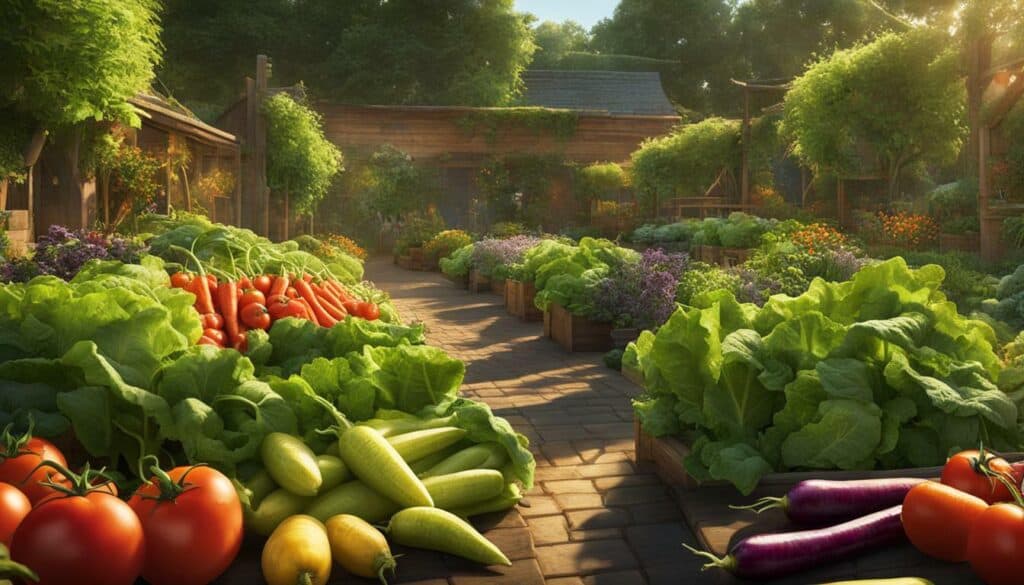
In addition to their aesthetic appeal, caladium bulbs can also serve a practical purpose in your garden design. Their lush foliage can provide shade and privacy when strategically placed around seating areas or patios. Furthermore, caladiums can be used to fill gaps and create a seamless transition between different areas of your garden, creating a cohesive and harmonious outdoor space.
| Benefits of Caladium Bulbs in Garden Design: |
|---|
| Enhance the beauty of your outdoor landscaping |
| Add vibrant pops of color |
| Can be used as focal points or accents |
| Create privacy and shade |
| Fill gaps and create a seamless transition |
Whether you’re a seasoned gardener or just starting out, incorporating caladium bulbs into your garden designs can elevate the overall aesthetic and make your outdoor space truly stand out. So grab your gardening tools, unleash your creativity, and get ready to unlock the beauty of nature with these stunning bulbs.
Selecting the Right Plants for Your Garden
Choosing the right plants for your garden is crucial for its overall success, whether you’re focusing on flowerbed ideas or cultivating your own vegetables. When it comes to selecting plants, it’s important to consider factors such as climate, soil conditions, and personal preferences. By understanding your garden’s unique characteristics, you can create a thriving and beautiful outdoor space.
Start by assessing the amount of sunlight your garden receives throughout the day. Some plants thrive in full sun, while others prefer partial or even full shade. Take note of any shady areas or spots that receive direct sunlight for several hours. This information will help you choose plants that are suitable for your garden’s light conditions.
Next, consider the soil quality in your garden. Test the pH levels and assess the texture of the soil. Some plants prefer acidic soil, while others thrive in alkaline conditions. Additionally, sandy or clayey soil may require amendments to improve its structure. By understanding your soil’s composition, you can select plants that will thrive in its specific conditions.
| Plant | Sunlight | Soil pH |
|---|---|---|
| Roses | Full sun | Neutral to slightly acidic |
| Hostas | Partial shade to full shade | Neutral to slightly acidic |
| Tomatoes | Full sun | Slightly acidic to neutral |
| Zinnias | Full sun | Neutral to slightly alkaline |
Once you have determined the sunlight and soil conditions in your garden, it’s time to choose the specific plants that align with your preferences and aesthetic goals. Consider factors such as bloom time, height, color, and fragrance. Create a list of plants that you find appealing and research their specific care requirements, as well as any potential pests or diseases they may be susceptible to.
Remember, a well-planned garden is not only visually appealing but also contributes to the health and balance of the ecosystem. By selecting the right plants for your garden, you can create a harmonious and thriving outdoor space that brings you joy and beauty throughout the year.
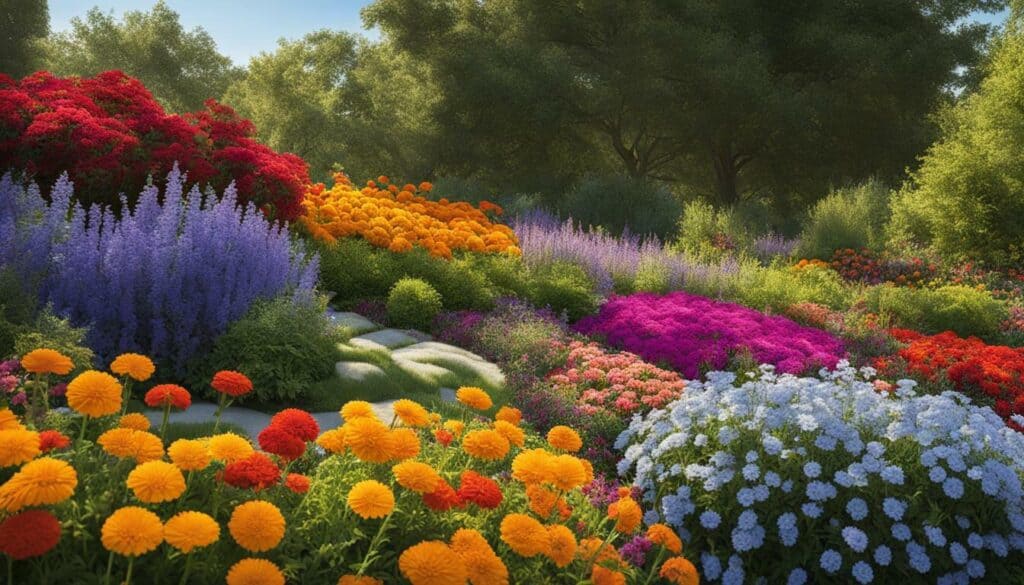
The Benefits of Mulching in Your Garden
Mulching is a fantastic technique that offers numerous benefits for your garden, including weed control, moisture conservation, temperature stability, and nutrient infusion. By incorporating the right garden tools and emphasizing garden maintenance, you can maximize the advantages of mulching.
One of the primary benefits of mulching is weed control. A layer of organic mulch, such as wood chips or straw, helps to suppress weed growth by blocking sunlight and preventing weed seeds from germinating. This reduces the need for frequent weeding, saving you time and effort in maintaining a weed-free garden.
Another advantage of mulching is moisture conservation. The layer of mulch acts as a barrier, preventing evaporation of moisture from the soil. It helps to retain water, ensuring that your plants have a consistent supply of moisture, especially during hot and dry periods. This not only reduces the frequency of watering but also helps plants withstand drought conditions.
Temperature stability is also crucial for plant health and growth, and mulching can help with this. The layer of mulch acts as insulation, protecting the soil and plant roots from extreme temperature fluctuations. It keeps the soil cooler in hot weather and warmer in cold weather, providing a stable environment for your plants to thrive.
| Garden Tools | Garden Maintenance |
|---|---|
| Shovel | Regularly inspect and replenish mulch |
| Rake | Remove weeds before mulching |
| Garden gloves | Monitor moisture levels and water as needed |
“Mulching is like giving your garden a protective blanket. It not only keeps weeds at bay but also conserves moisture and maintains a stable temperature for your plants.”
Lastly, mulching provides nutrient infusion to your garden. Organic mulches gradually break down over time, releasing essential nutrients into the soil. This natural process enriches the soil, improving its fertility and promoting healthy plant growth. It also encourages beneficial soil organisms, such as earthworms, which further contribute to soil health.
Summary
- Mulching offers benefits such as weed control, moisture conservation, temperature stability, and nutrient infusion.
- Using the right garden tools and practicing regular garden maintenance maximizes the advantages of mulching.
- Mulching suppresses weed growth, reduces the need for frequent weeding, and saves time and effort.
- A layer of mulch helps retain soil moisture, reducing the frequency of watering and helping plants withstand drought conditions.
- Mulching provides temperature stability by insulating the soil and protecting plant roots from extreme temperature fluctuations.
- Organic mulches gradually break down over time, enriching the soil with essential nutrients and promoting healthy plant growth.
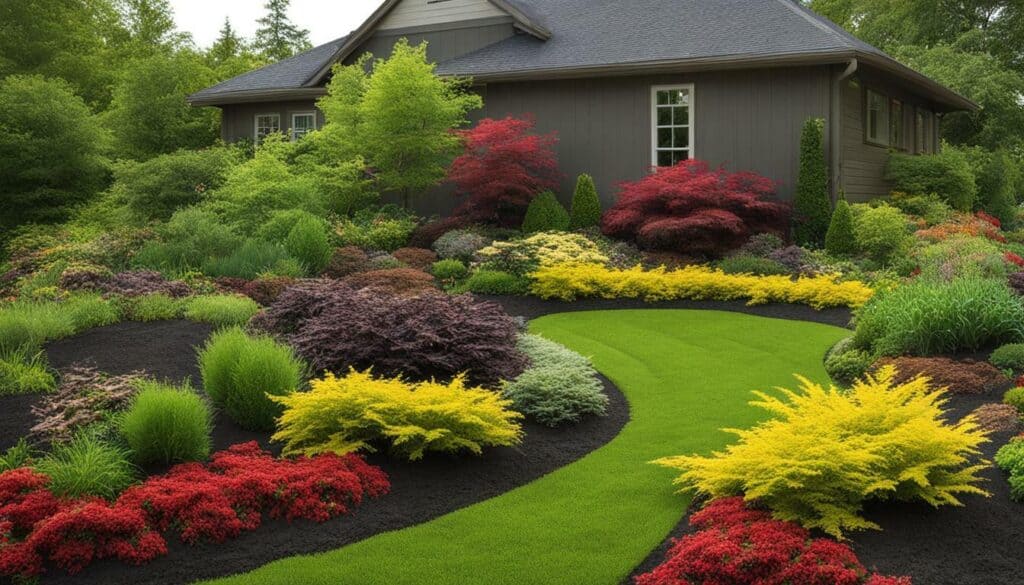
Conclusion
The Essential Garden Guide has equipped you with valuable gardening tips and advice to unlock the beauty of nature in your own garden. Start your journey towards a vibrant and thriving garden today!
With this comprehensive guide, you have gained a deeper understanding of caladium bulbs and their specific care requirements. You now know the ideal timing and propagation methods for planting these bulbs, as well as how to create optimal planting conditions. You have also learned the importance of proper watering and care, as well as how to manage the bulbs during their dormancy period.
In addition to these practical tips, The Essential Garden Guide has also provided insights on troubleshooting common issues that may arise with caladium bulbs. You have learned how to address leaf discoloration, pests, and diseases effectively. Furthermore, you have discovered how these bulbs can enhance the beauty of your garden designs, whether in flowerbed ideas, vegetable gardening, or outdoor landscaping.
Lastly, you have been introduced to the benefits of mulching in your garden. You now understand how mulching can contribute to weed control, moisture conservation, temperature stability, and nutrient infusion. By implementing these practices and using the right garden tools, you can ensure that your garden thrives and remains a breathtaking oasis of nature’s beauty.
How Does Understanding Soil Help in Creating a Beautiful Garden?
Understanding soil is crucial when it comes to creating a beautiful garden. The beginners guide to soil equips you with knowledge about its composition and nutrient levels, enabling you to choose the right plants and provide them with optimal conditions. By understanding soil, you can improve its quality, adjust pH levels, and ensure proper drainage, resulting in a flourishing and stunning garden.
FAQ
Q: What is The Essential Garden Guide?
A: The Essential Garden Guide is a comprehensive resource that provides valuable information on growing caladium bulbs successfully. It covers topics such as understanding caladium bulbs, planting them at the right time, methods of propagation, ideal planting conditions, watering and caring for them, managing them during dormancy, and troubleshooting common issues.
Q: How do I understand caladium bulbs?
A: Understanding caladium bulbs is crucial for successful gardening. The guide explains their characteristics, growth patterns, and requirements, helping you cultivate them effectively.
Q: When should I plant caladium bulbs?
A: The guide provides insights into the ideal timing for planting caladium bulbs, ensuring that you provide them with the best conditions for growth.
Q: How can I propagate caladium bulbs?
A: The guide offers various methods of propagation, allowing you to expand your caladium bulb collection and create more beautiful garden displays.
Q: What are the ideal planting conditions for caladium bulbs?
A: The guide highlights the importance of choosing the right location with the necessary sunlight requirements, preparing the soil with the right mix of nutrients and texture, and planting the bulbs at the proper depth and spacing.
Q: How should I water and care for caladium bulbs?
A: The guide provides tips on watering, caring for the bulbs during dormancy, and addressing common problems like leaf discoloration, pests, and diseases, ensuring their health and vitality.
Q: What should I do during the dormancy period of caladium bulbs?
A: Managing caladium bulbs during their dormancy period is crucial for their long-term success. The guide explains the necessary steps to take during this phase to ensure their proper development.
Q: What are some common issues with caladium bulbs and how can I troubleshoot them?
A: The guide addresses common problems that may arise with caladium bulbs and provides troubleshooting tips to help you overcome these challenges.
Q: How can I create beautiful garden designs with caladium bulbs?
A: The guide offers insights on creating stunning garden designs using caladium bulbs, enhancing the overall aesthetics of your outdoor space.
Q: How do I select the right plants for my garden?
A: The guide discusses the importance of selecting the right plants for your garden, considering factors such as flowerbed ideas and vegetable gardening, ensuring a harmonious and thriving garden.
Q: What are the benefits of mulching in my garden?
A: The guide highlights the benefits of mulching, including weed control, moisture conservation, temperature stability, and nutrient infusion. It explains how to implement mulching practices effectively using the right garden tools and maintenance techniques.

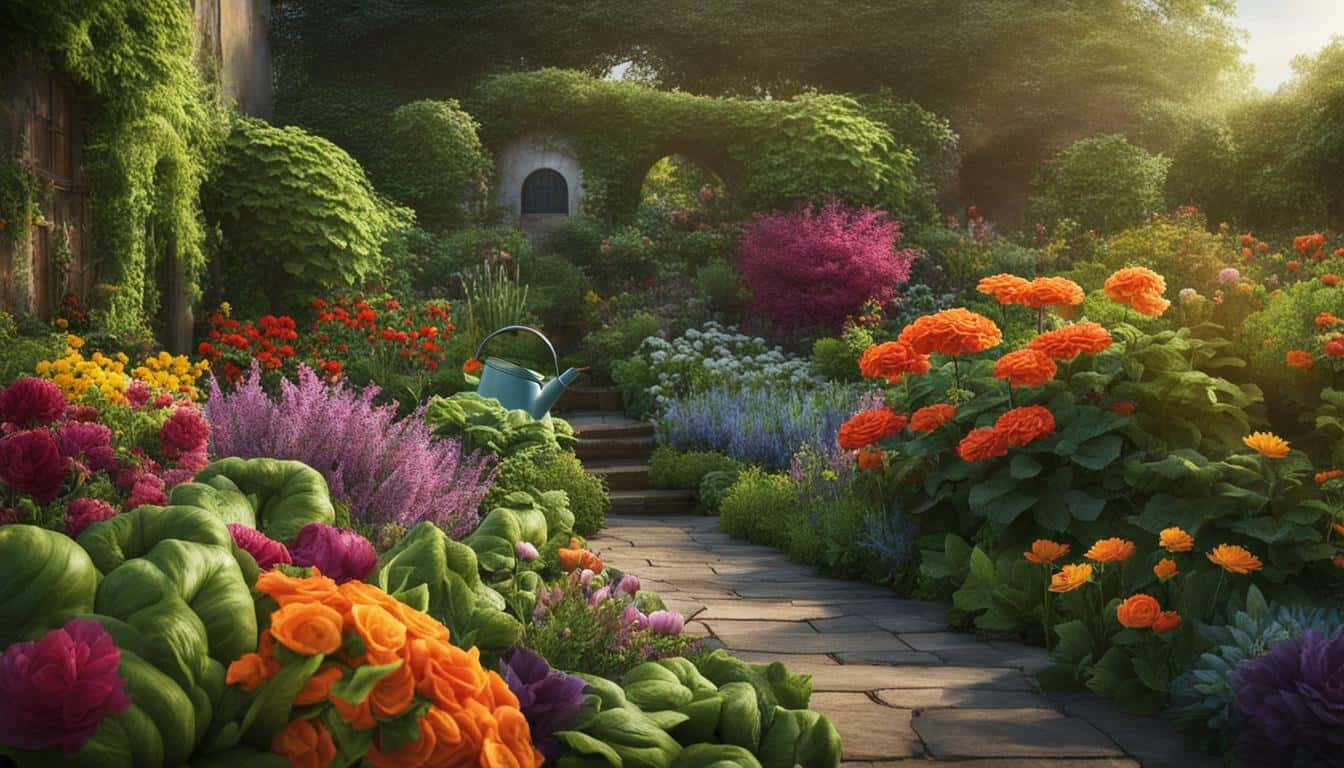



Leave a Reply